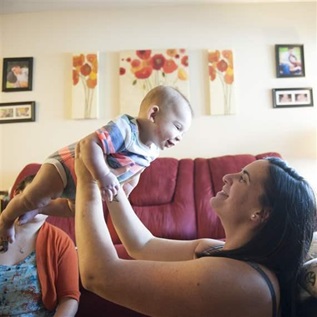Solving Social Ills Through Early Childhood Home Visiting
QUICK SUMMARY
The Pew Home Visiting Campaign presents 12 studies highlighting gains in education, health and future livelihoods at less cost to taxpayers through home visiting Read a Pew brief that synthesizes key findings from a new body of home visiting research It explores the importance of program quality and target populations—and the interactions between them—in determining ultimate outcomes for children and families.
Introduction
Extensive research shows that evidence-based, voluntary home visiting programs improve child and family outcomes, and save money for states and taxpayers. Now, the next generation of research is deepening understanding of those program elements that are essential to success, ways to improve existing models, and factors to consider in tailoring home visiting to local contexts and particular target populations.
The following 12 studies—commissioned by the Pew Home Visiting Campaign-underscore the need for continued evaluation and monitoring of home visiting services in order to maximize effectiveness as programs expand to serve more families in a greater diversity of settings. Indeed, several of the studies identify key challenges policymakers need to address as they expand state programs. Specifically, the reports detail:
- The benefits and limitations of home visiting for children, families, and taxpayers
- The value of expanding home visiting to more families
- The important program characteristics that predict better outcomes
- The advances in measuring program quality in home visiting
- The advantages of understanding and encouraging greater program participation
- The new approaches being added to existing strategies
This work grew out of a desire to support a research agenda aimed at increasing policymakers' confidence in and commitment to home visiting and at expanding the body of knowledge needed to improve services for families. The views and opinions expressed in the reports are those of the author(s) and do not necessarily reflect the views of the funders.
This research was made possible by the generous contributions of the Doris Duke Charitable Foundation and the Children's Services Council of Palm Beach County. These findings are exclusively the work of the commissioned researchers and do not necessarily reflect the view of Pew or the other funders.
The full reports and executive summaries are available for download. Below are brief overviews of the findings with links to the reports.
Pew-commissioned home visiting research was featured in the January 2013 issue of the Journal of Zero To Three. Read a letter from Pew Home Visiting Campaign Director Libby Dogget.
Scroll forward or extend the table of contents to read brief overviews of the finding with links to the reports.
The Benefits of Home Visiting to Children, Families, and Taxpayers
Five papers provide new evidence of the benefits of home visiting for children and families…and taxpayers' bottom line. One paper by Kristen Kirkland and her colleagues at the State University of New York-Albany used seven-year follow-up data from a randomized controlled trial to find that home visiting has significant positive impacts on the school readiness of children entering first grade. Download the executive summary and full report.
Similarly, Carla Peterson and her colleagues at Iowa State University analyzed follow-up data from 1,053 families who received home visits as part of the Early Head Start Research and Evaluation Project, a large randomized controlled evaluation. They found that greater involvement in home visiting when the child was an infant and toddler predicted better child developmental status in pre-kindergarten, better child outcomes when the child was in fifth grade, and more stimulating and nurturing home environments in both pre-k and fifth grade. Download the executive summary and full report.
But not all of the findings were positive. In a randomized controlled evaluation of the Healthy Families Massachusetts program, M. Ann Easterbrooks and her colleagues at Tufts University found that some (but not all) subsamples of the families in the state program showed higher rates of child maltreatment and neglect than families not enrolled in the program. The authors speculate this may be the result of surveillance bias, that is, because families were participating in the program, incidences of maltreatment were more likely to be reported than they would be for non-participating comparable families. The researchers also found evidence that maternal depression may block program effectiveness. Download the executive summary and full report.
Taxpayers also benefit from these programs. Ted Miller of HBSA, Inc., a non-commercial research organization, developed a benefit-cost calculator for states that utilize Nurse Family Partnership programs. The report shows cost and financial benefit data individualized to each state in order to estimate the expected monetary benefits to a state by serving families through NFP programs.
Similarly, in a small follow-up study of the My Baby and Me home visiting program, University of Notre Dame professor John Borkowski and Penn State Harrisburg's Jaelyn Farris found no differences in IQ, language development, or early literacy skills at five years of age between children randomly assigned to the program or not. Children in both groups scored close to the general population average on these measures, but the authors also acknowledge the sample may have been too small (only 92 children) to detect any differences. Download the executive summary and full report.
The Value of Expanding Home Visiting to More Families
Two studies presented by Pew found evidence that broadening the types of families served in a home visiting program resulted in better family health care and lower health care costs. First, in a randomized controlled trial of Durham Connects, a universal access home visiting program in Durham County, North Carolina, Duke University professors Kenneth Dodge and Ben Goodman found that mothers and children assigned to Durham Connects had more positive parenting behaviors, less maternal depression, fewer overnights in the hospital for the child, and reduced use of emergency medical services. This last result alone resulted in a return on investment of $1.59 for every dollar spent on the program by the time the child reached six months of age. Download the executive summary and full report.
In the second report, a comparison of outcomes for first-time mothers and mothers with two or more children participating in Healthy Families Virginia, William and Mary's Joseph Galano and Lee Huntington of Huntington Associates found that both types of families benefited equally in terms of higher childhood immunization rates, better home environments, and greater spacing between pregnancies. An earlier randomized controlled study established that, for both groups of mothers, these outcomes resulted from participation in the Healthy Families Virginia program. Download the executive summary and full report.
The Important Program Characteristics That Predict Better Outcomes
A meta-analysis of 55 studies examining the effects of home visiting programs on parents' childrearing behaviors and children's cognitive and language development by evaluation research firm James Bell Associates found that home visiting had an overall positive average on these outcomes. The researchers found that the program characteristics most strongly associated with better results in the areas of parenting behavior and skills included activities that created a stimulating home environment and content that addressed parental mental health and substance abuse.
In the area of child cognitive and language development, the meta-analysis study found that program characteristics most strongly associated with better outcomes were teaching parents what to expect about their child's development; responsiveness, sensitivity to cues, or nurturing; promotion of child's socio-emotional development; promotion of child's cognitive development; as well as opportunities to role play and practice skills. Download the executive summary and full report.
Advances in Measuring Program Quality in Home Visiting
Jon Korfmacher and his colleagues at the Erikson Institute developed and field-tested their Home Visiting Program Quality Rating Tool in 21 home visiting programs in Illinois and Wisconsin. The tool is the first in the field to assess the quality of home visiting programs across different models and measures home visitor characteristics, program service delivery, program content and characteristics, program management and development, and monitoring. Download the executive summary and full report.
The Advantages of Understanding and Encouraging Better Program Participation
Pamela Klebanov of Teachers College, Columbia University analyzed data from 377 families with low birthweight or premature infants who received home visiting as part of the Infant Health and Development Program. In her randomized controlled evaluation, Klebanov found that 85 percent of the families fell into “medium stable” or “high” level patterns of receipt of home visiting across the three-year program. These families experienced statistically significant positive effects on their children's home learning environment and on the child's IQ and verbal scores when compared with families who were not offered services. Families with “low” or “medium-decreasing” patterns of service receipt did not show improved outcomes. Download the executive summary and full report.
Jerrilyn Radcliffe and her colleagues at the Children's Hospital of Philadelphia report on the MOM Program, a small home visiting program designed to encourage low-income mothers in an urban setting to obtain appropriate health and developmental services for their children ages zero to three. The retention rate of MOM program participants in the study was very high, and the researchers found few differences between the mothers who were and were not retained for the full duration of the program, except that mothers of boys were more likely to stay in the program. Download the executive summary and full report.
New Approaches Being Added to Existing Strategies
Researchers at the University of Chicago developed Dads Matter, a module-based addition to home visiting programs that is intended to address and enhance fathers' positive role in their child's development. The developers are currently field-testing the modules to determine their feasibility and acceptability. Download the executive summary and full report.
Acknowledgements
All 12 of the studies were peer reviewed by Child Trends, an independent, non-partisan research center dedicated to improving the lives of children and their families.
The Campaign wishes to express our sincere thanks to the researchers, members of the project's research advisory panel, and peer review committee. As peers of the portfolio's primary audiences, research advisory panel members provided invaluable expertise and advice to ensure that the selected study proposals address issues faced by a diverse range of home visiting models. Studies in Pew's portfolio were peer reviewed by the following individuals, through a process managed by Child Trends under the direction of Amy Blasberg. We thank them for their expert comments and insights: Amanda Berger, Kimberly Boller, Natasha Cabrera, Nina Chien, Nicole Forry, Tamara Halle, Chris Herbst, Karin Malm, David Murphey, Daniel Princiotta, Zakia Redd, Rose Ann Renteria, Mindy Scott, Rebecca Starr, Sharon Vandivere, and Wladimir Zanoni.











